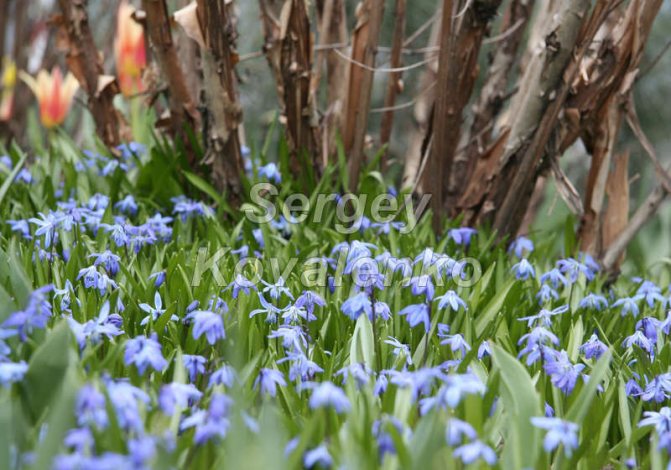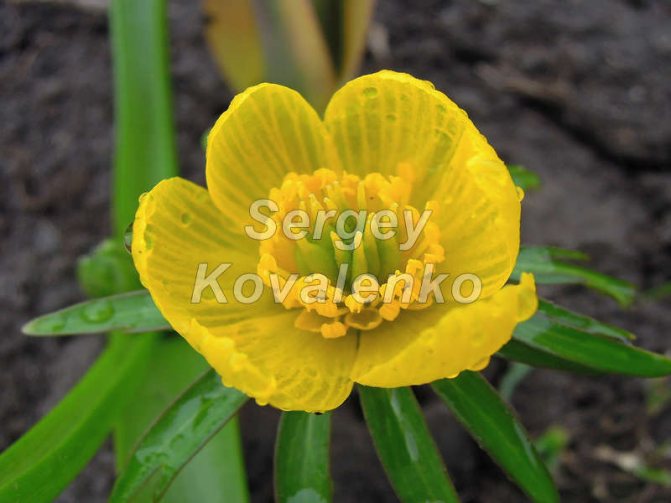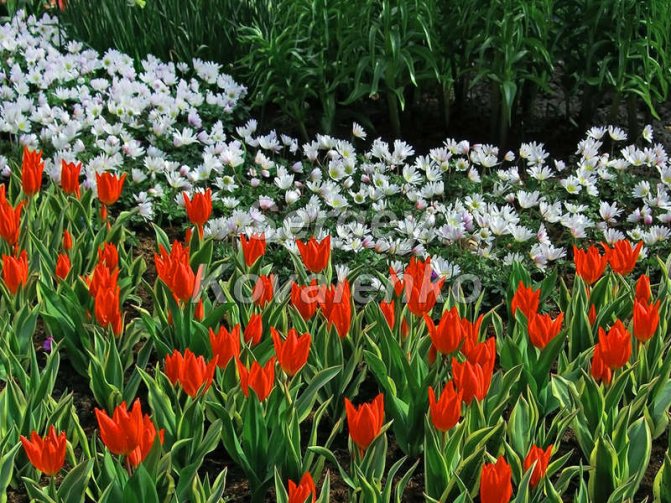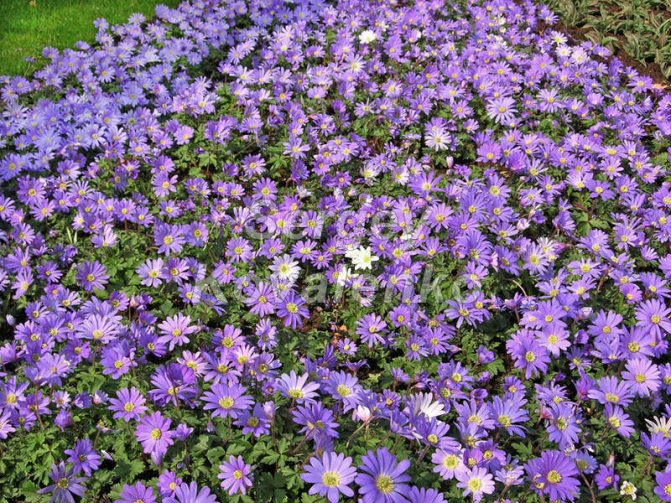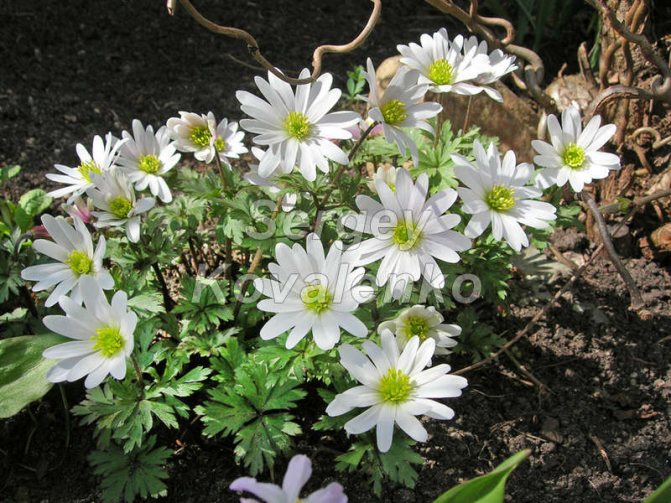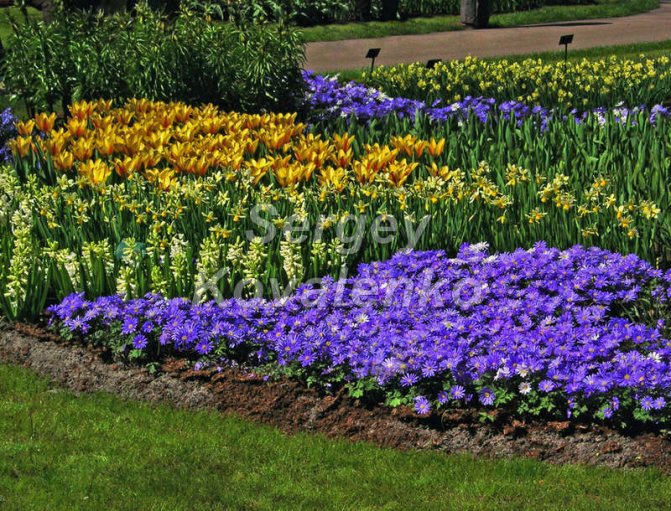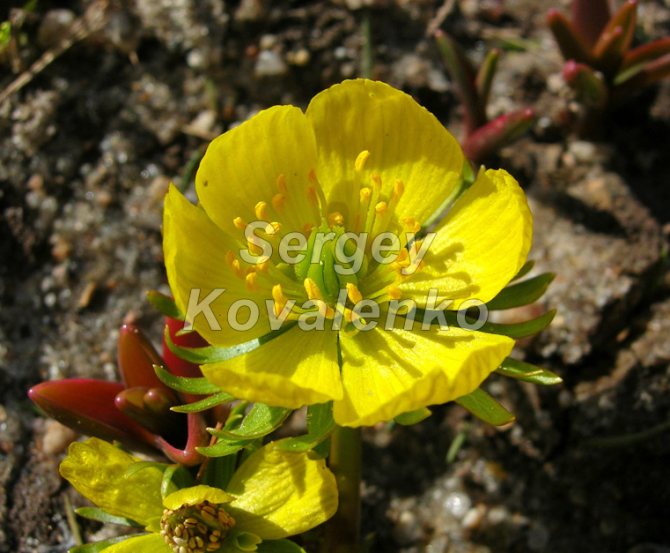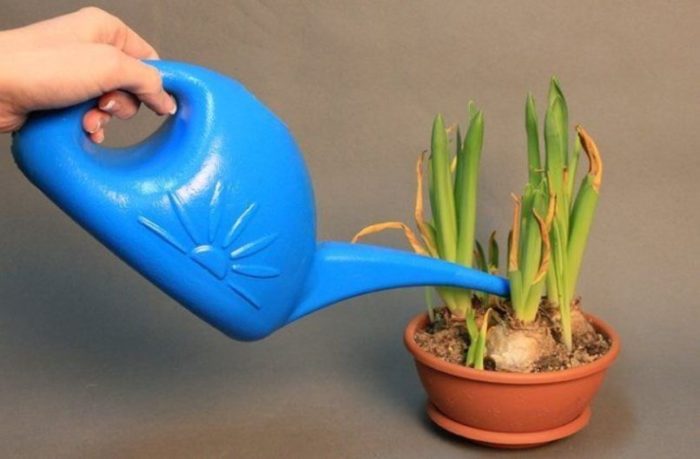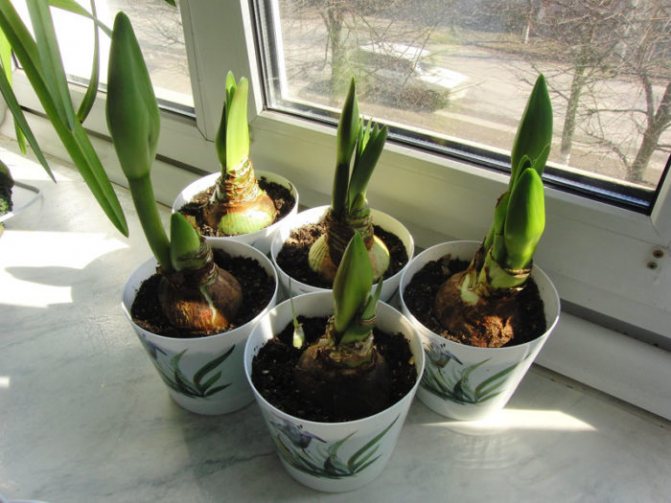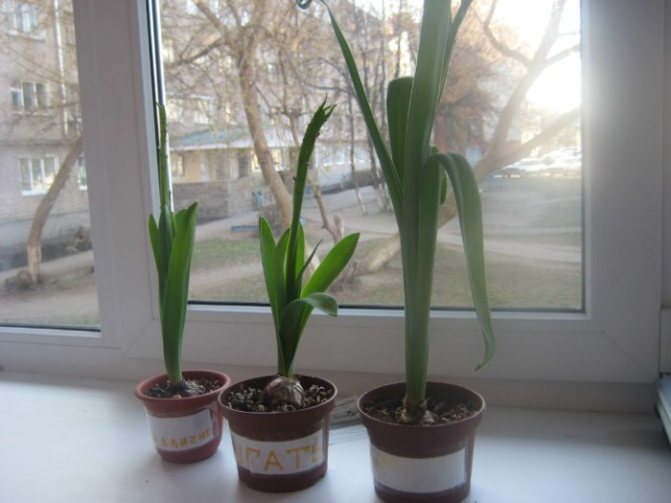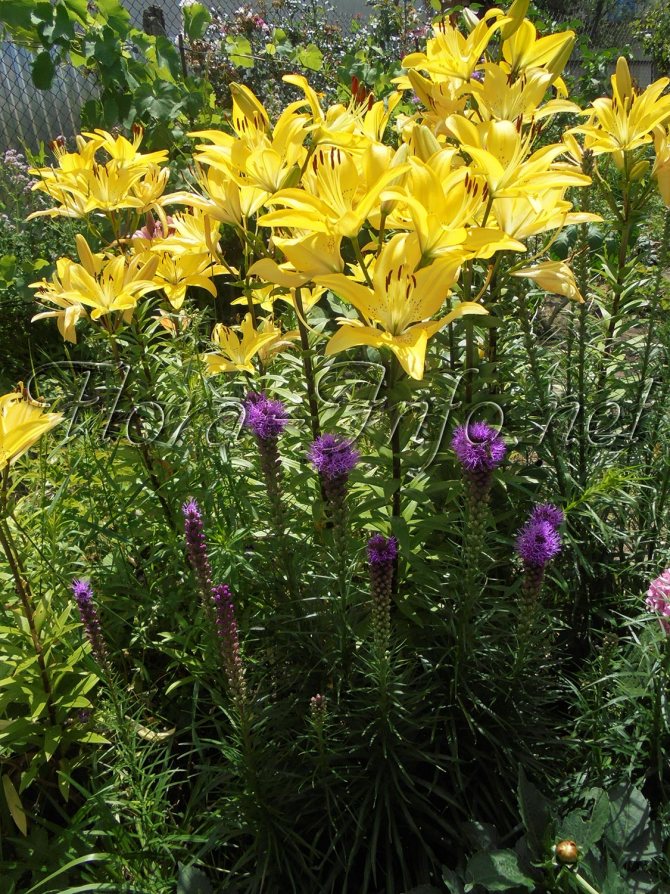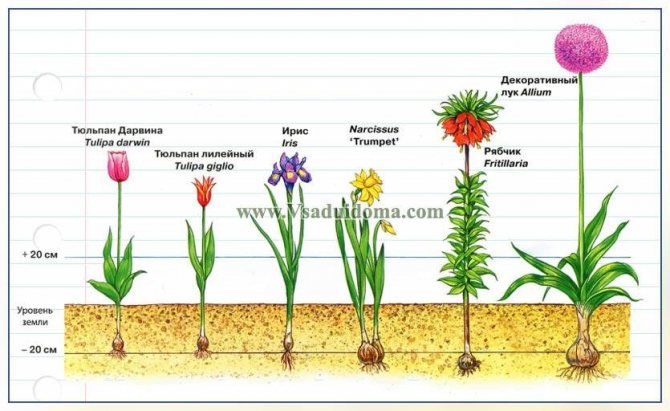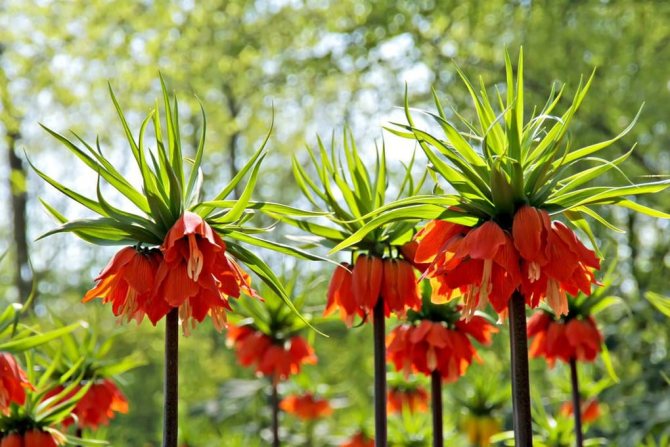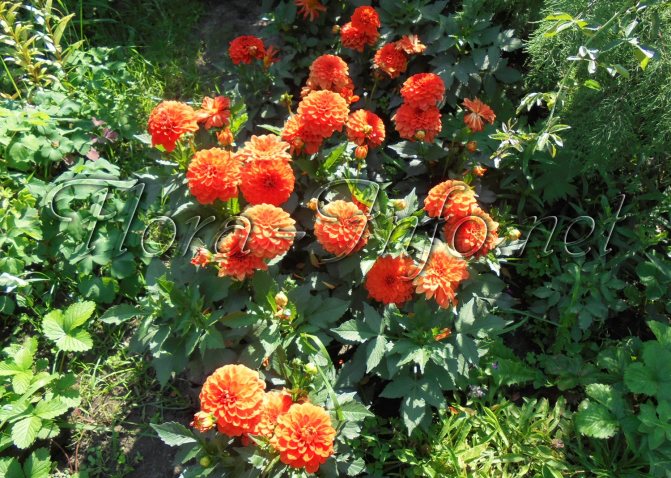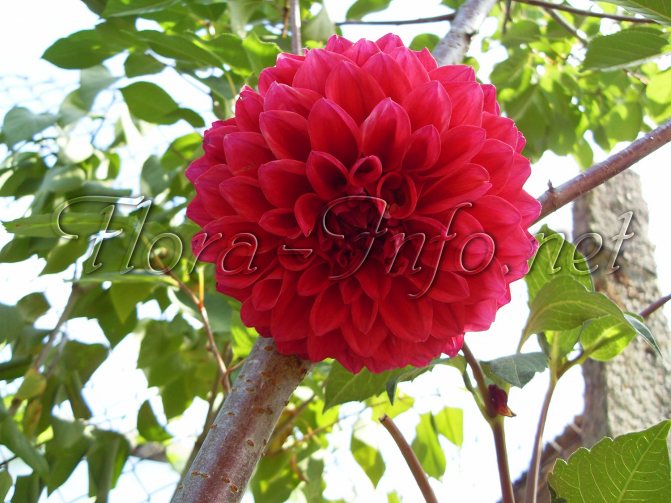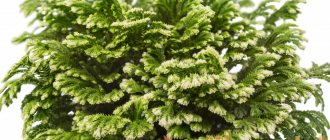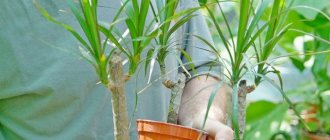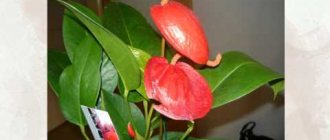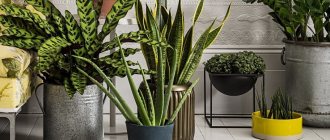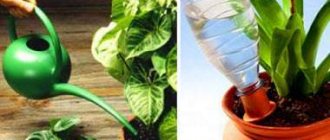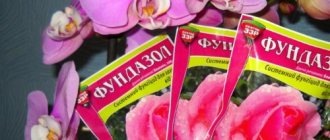The first spring flowers appear in March, sometimes even among the remnants of snow. And these are small-bulbous: woodlands, muscari, crocuses, grouse snowdrops and lilies of the valley.
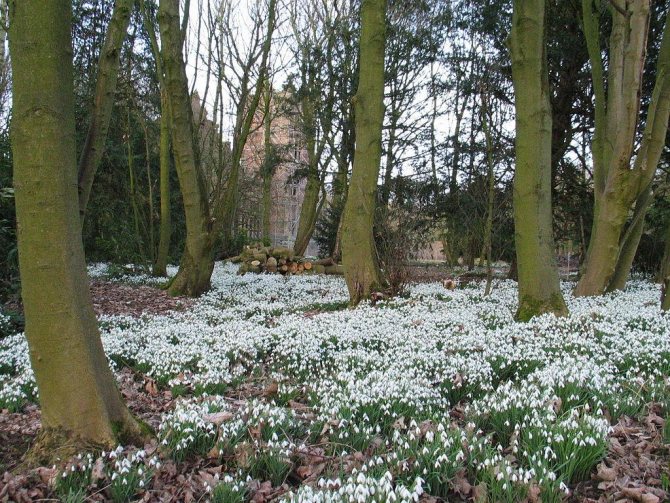
These are flowers known to many. But there is also chionodoxa, erythronium, iridodictium, white flower, poultry. They are little known to flower growers, but in vain. Delightful flowers delight the eye after winter.
Overview of popular species
The term "bulbous" includes several dozen plants grown at home for ornamental purposes. The characteristic feature is the bulb, which is the embryo of the plant and serves as a store of nutrients. Leaves and flower stalks sprout from the bulb, on which buds are tied. The list of bulbous indoor plants is extensive, in addition, some have several names.
Spiral albuka
Perennial succulent albuca spiral is a member of the asparagus family, native to South Africa. The flower got its name due to the unusual shape of the leaves, twisted into a spiral. This feature allows the albuca to retain moisture, allow air to pass through, and not overheat.
In early winter, a small, round bulb produces a rosette of bright green leaves. The brighter the sun shines, the tighter the spiral turns. In the middle of spring, yellow-green flowers with a diameter of 3 cm, collected in inflorescences, bloom on thick and fleshy peduncles. Since the plant is native to the southern hemisphere, the albuca needs a state of dormancy in summer.
At this time, the leaves die off, growth stops. The optimum temperature during the growing season is about 25 ° C, backlighting is needed. For the rest period - a room with a temperature of 13 ° C.
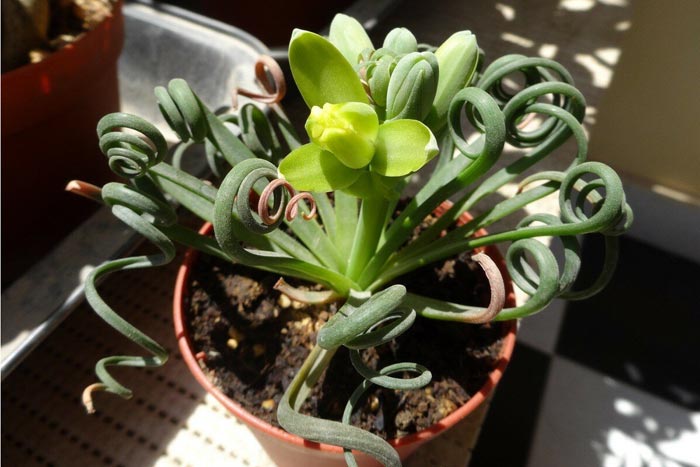

Amaryllis
Amaryllis is a spectacular bright perennial plant from the amaryllis family. The flower has long leaves that look like dark green belts. A large bulb produces 1–2 peduncles, each of which has 2 to 6 flowers pink, orange, white or red. Flower diameter - 8-10 cm, 6 petals have pointed edges.
With proper care, re-flowering can be achieved. Breeders have developed varieties with a large number of petals, terry, terry and super-terry. The variety of colors is amazing - besides the usual ones, you can see varieties with bright crimson, coral, dark cherry, pale green, purple, orange flowers.
Narrow-petal varieties have been very popular recently; they look good in flower arrangements.
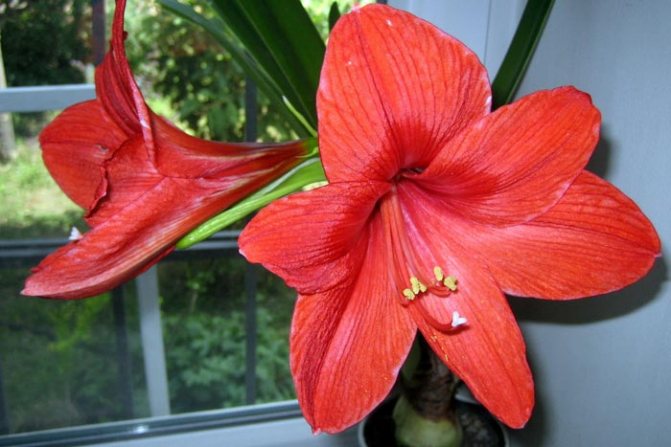

Bovieya
The appearance of the plant is completely uncommon for bulbous plants. A large turnip-like bulb is almost completely on the surface of the soil, thin herbaceous shoots emerge from it. They are covered with false leaves that look like needles. The real leaves are located at the top of the bulb, these are 2 scales.
The bulb is constantly growing, can reach a diameter of 30 cm. Peduncles grow up to 3 m in length, they curl in the form of a spiral around the support... On the peduncles there are a huge number of lateral shoots and tiny twigs, which give the plant a decorative effect.
The flowers bloom at the ends of the climbing shoots - they are pale green in color, no more than 1 cm in size. If the plant is not provided with conditions for a dormant period, the peduncles remain throughout the year. Bovia is poisonous, any contact with mucous membranes and skin should be avoided.
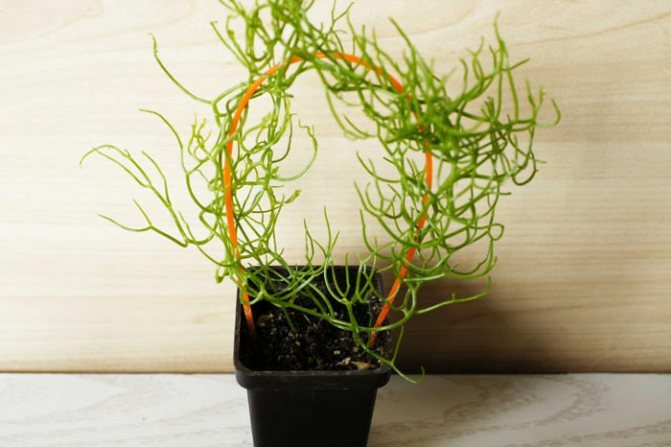

Vallota
Vallota is also known under the names "Cyrtanus" and "Krinum the Beautiful". Belongs to the amaryllidaceae family.
Popular indoor types:
- Vallota the beautiful - it has narrow dark green leaves up to 45 cm. The flowers are large, the diameter is 8 cm. The buds with six petals are similar to bells, their stamens are directed upwards. Up to 7 flowers are formed on a long peduncle.
- Vallota purple - all parts of the plant are smaller, the color of the buds is bright red.
- White vallot - produces flowers that resemble lilies.
- Pink - light green leaves up to 25 cm long, bright pink flowers.
The bulb allows the flower to endure bad weather conditions for a long time, at which time the above-ground part of the plant dies.
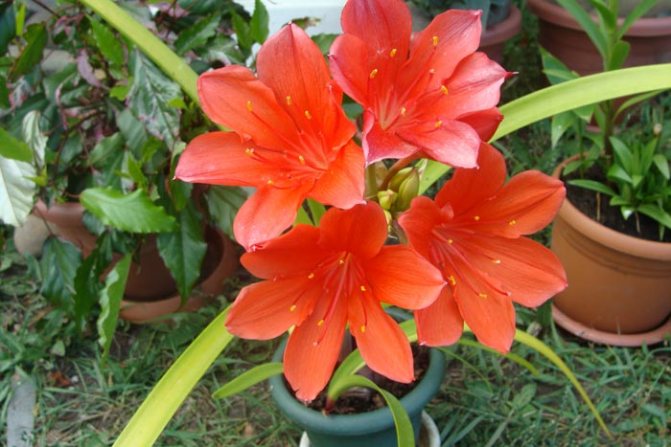

Weltheimia
There is a debate about the classification of Weltheimia among scientists, they attribute it to different families. This bulbous plant with a height of 50-60 cm has a rosette of dense bright green leaves... Leaves are oblong, elongated, with wavy edges. This gives the flower a special decorative effect.
At the beginning of winter, the bulb produces a long peduncle on which there is a brush-shaped inflorescence. The inflorescence includes up to 60 tubular flowers of all shades of pink. The flowers are medium-sized, their length is 2.5 cm, they are lowered down.
The following species are grown at home:
- Cape Weltheimia with bluish-green wavy leaves and pale pink flowers;
- bracts;
- green-leaved.
Adult plants can produce several peduncles. It is quite rare in our apartments, there are problems with growing, since the flowering period requires a temperature of 10-14 ° C.


Worsley
Worsley noble is a rare species of blue amaryllis. The main feature of the hairs is the color of flowers, which varies from lilac and bright blue to deep blue. On one peduncle there can be 15 flowers at the same time, each of which opens up to 15 cm in diameter. The central part of the flower is white, the petals are pointed.
The leaves are narrow, long, green. At home, the flowering period is in the summer. Plants are very whimsical to care for, they have a high price. After flowering, seeds are formed that can be used for propagation. It is necessary to pick up light rocky sandy soil, provide good drainage. Worsley feels good in a cramped pot.


Gemantus
Gemantus is the choice of lovers of exotic species. This herbaceous perennial has several wide and thick leaves arranged on short petioles. The leaves grow in pairs, differ in their characteristic shape - they are slightly bent in the center, with wavy edges. The type of leaves gave the plant another name - "deer tongue".
In different varieties of Hemantus, the leaves change color from gray to green, can be pubescent or smooth, monochromatic or spotted. An inflorescence with a diameter of about 5 cm appears on the peduncle. Hundreds of small flowers are surrounded by several colorful bracts, forming a lush fluffy ball.
Hemantus is decorated with ripe fruits - berries of red, pink, orange or white color. Florists are scared off by the unpleasant smell of flowers.


Hymenokallis
The genus Hymenokallis has about 60 species. Long leaves are collected in a rosette, they are colored in different shades of green. The flowers are very decorative. On a long peduncle, the core of the flower opens in the form of an open umbrella, from which 6 narrow long petals hang down, their length reaches 20 cm.
The stamens are decorated with large oval anthers of bright yellow or orange color. Several flowers (up to 16 pieces) form a large inflorescence, they bloom alternately. Some varieties have variegated leaves.All varieties of hymenokallis have a delicate aroma.
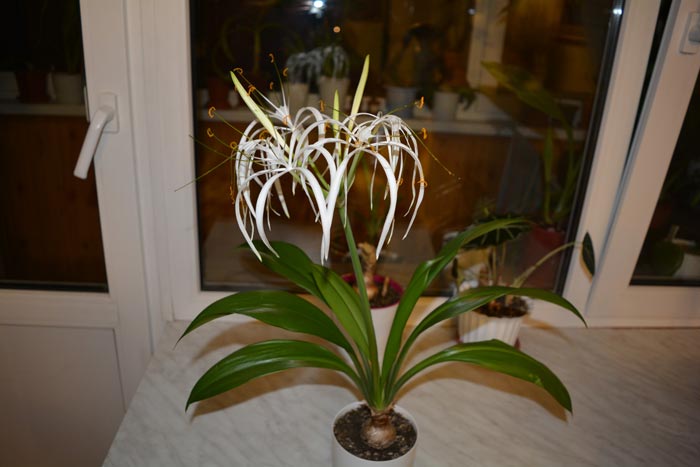

Hippeastrum
Blooming hippeastrum is a delightful sight. The color scheme is delightful. Snow-white, bright pink, fiery red, orange, striped and speckled flowers stand out brightly against the background of lush greenery. The leaves grow up to 50 cm, long stalks rise above them.
Flowers form an inflorescence - an umbrella containing up to 6 buds. The diameter of the flower varies depending on the variety, the maximum size is 25 cm... Breeders have bred terry varieties. Usually hippeastrum blooms in winter, with good care it is really possible to achieve another flowering. By artificially creating dormant conditions, you can force the hippeastrum to throw out the peduncle and bloom at a convenient time for you. Flowers are stored for a long time in a cut state, they are used to create bouquets and compositions.
Late spring is the time for daffodils, tulips and bearded irises
In early to mid-May, when the first bulbous have lost their flower stalks, it is time for daffodils. For all their simplicity, they are very diverse. Their delicate persistent aromas attract the attention of a huge number of butterflies, bees, bumblebees, beetles.
At the same time, blue muscari are blooming.
Tulips are connected a little later. They can bloom continuously for a month, replacing each other, if the species are correctly selected.
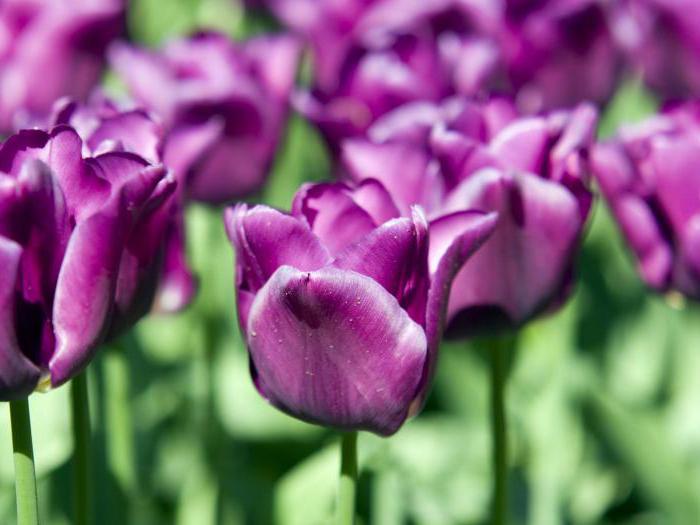

Bearded irises, aiming up their stems, delight flower growers with a combination of bright shades. They are completely unpretentious, they fit into any compositional solutions.
How to create ideal growing conditions
Bulbous plants react painfully to both excessive watering and excessively dry air. With insufficient moisture, the condition of the leaf stems is disturbed, flowering worsens. Most pests develop well in a dry atmosphere, sufficient humidity is necessary to prevent infestation by aphids, scale insects, and spider mites.
A stable room temperature improves plant growth, sharp fluctuations slow it down. The comfortable temperature for normal growth is 15-25 ° C, during the rest period it must be reduced to 10-13 ° C.
Most indoor bulbous plants love light, but crocus, for example, prefers light shading, diffused light. Hazel grouse and colchicum grow well in the shade. A suitable place is windows facing south or southeast, but cover the plant from direct sunlight. Bulbous plants do not need additional illumination, it can only be used to accelerate the onset of flowering.
Spring flowering varieties
After the snow melts, primroses bloom in containers and on the lawn - snowdrops, white leaves, crocuses. With their help, the garden comes to life, waking up from hibernation. We already know that the bulbs planted in the fall have a sufficient supply of nutrients, so they require almost no maintenance.
Their compact groups will decorate empty lawns, rock gardens and places under large trees in the country garden. After the end of flowering, you will need to cut off their upper withered part. Mixborders from primroses will look especially beautiful against the background of waking up shrubs. Then they will disguise the blossoming perennials with their yellowed leaves.
The first to wake up in the spring:
- snowdrops;
- daffodils;
- crocuses;
- tulips;
- hyacinths;
- irises;
- amaryllis;
- muscari;
- anemones;
- hazel grouses.
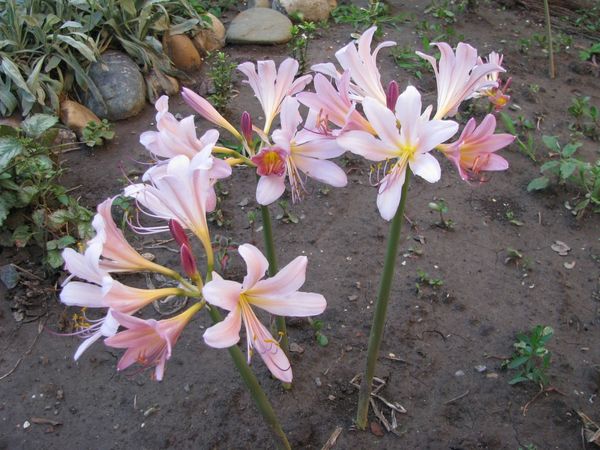

Amaryllis in the country
General recommendations for the care of bulbs
Caring for bulbous indoor plants is not difficult. During warmer months, keep flower pots in a bright room at 20-25 ° C. In winter, transfer to a cool room with a temperature of 10-13 ° C. Maintain high air humidity, make sure that the soil is not waterlogged.
Water regularly in the spring and summer, but do not overwhelm the flowers. In winter, keep watering to a minimum.
Don't forget to fertilize.Plants do not need additional lighting if they are located on windows facing south, west or east. Inspect flowers regularly to prevent insect pests or fungal infections.
Scilla
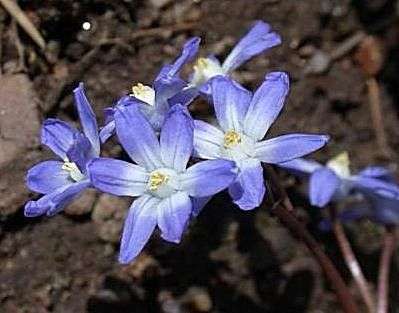

Scylla flowers are blue, less often purple or almost white. It blooms in early spring. Photophilous, but tolerates partial shade. Planting depth of Scyllas is 5-8 cm with an interval of 10 cm. It can grow in one place for many years. Easily propagated by seeds. Scyllas are sown in the fall in open ground. Seedlings bloom for 2-3 years. Used to create a bright carpet in groups against the backdrop of lawns, in rock gardens, under shrubs and trees. Good for winter distillation.
Planting and transplanting
The beauty and health of an indoor flower depends on the planting material. The best time for planting is autumn. Examine the bulbs carefully, they should be strong and healthy.
Planting procedure:
- For disinfection, prepare a 1% solution of potassium permanganate, soak the bulbs in this liquid for half an hour.
- Pay attention to the size of the pot, it should not be much larger than the bulb itself. In large pots, the plant will develop children, and flowering will not come.
- Make holes for drainage, add a layer of small stones, expanded clay, pebbles, gravel. Good drainage will keep the bulbs from rotting.
- Cover with a layer of sphagnum and charcoal, add a layer of soil, place the onion, sprinkle with earth. Do not deepen the bulb.
- Water the soil, put the pot in a cool place.
After the leaves appear, transfer to a light window.
Young plants are transplanted every year into a larger pot, adults - every few years. If roots peep out of the drainage hole, the plant needs a transplant. For bulbous plants, the optimal time is the end of the dormant period.
Loose and fertile soil for transplanting can be made independently or purchased at a flower shop. The prepared soil is compiled in accordance with all requirements, is safe and contains the necessary nutrients. In order not to injure the root system, use the transshipment method when transplanting.


Pushkinia
This garden primrose is also called miniature hyacinth for its beautiful pale blue flowers that appear in April, as soon as the snow begins to melt. Pushkinia - unlike other small-bulbous crops - has a rather long vegetative period. In favorable weather conditions, the flowers last for 3-4 weeks.
The plant is very unpretentious and perfect for growing on alpine slides, lawns, gardens and landscape parks. Pushkinia prefers well-lit or slightly shaded areas. The ideal landing site is open hills, which are the first to warm up and on which snow melts at the end of March.
Good drainage is important for pushing. Flowers are planted with bulbs or seeds. Planting - regardless of the method - is carried out in September-October. When using bulbs, the plant blooms the next spring, and when sowing with seeds - only for the 3-4th year.
Watering and feeding
When watering bulbous indoor flowers, you must remember the individual approach. Each species has certain requirements for soil moisture. Some plants are drought tolerant, others prefer a humid environment. The frequency and abundance of moisture directly depend on the stage of plant development.
Experienced florist recommendations:
- Some bulbous plants need complete rejection of irrigation during the dormant period. For other plants, it is necessary to keep the soil moist, water is needed to prevent the bulbs from drying out. Reduce not only the regularity of watering, but also the amount of water 2-3 times.
- With the beginning of the growing season, gradually transfer the plant to the usual watering regime, use a small amount of water, the soil should be constantly slightly moistened.
- Only after the active growth of leaves begins, bring the amount and regularity of watering to generally accepted norms in the summer.
- Use soft, slightly warmed water, preferably thawed or rainwater. The water temperature for irrigation in winter is 20-23 ° C.
- Pour water close to the sides of the pot to prevent liquid from spilling onto the bulb and stem.
- Add water in portions, each time check how wet the soil is.
- Remove excess water from the sump immediately.
- Water the flowers in the morning and evening.
Generally accepted recommendations are abundant watering during the growing stage, reducing or stopping irrigation during the dormant period. It is more convenient to use the method of bottom irrigation, this will exclude waterlogging of the soil and rotting of the bulbs.
The main rule to remember when fertilizing bulbous plants is to underfeed rather than overfeed.
The main chemical elements that flowers need:
- the size and number of leaves, their growth rate depend on the nitrogen content;
- phosphorus is necessary for the correct growth of peduncles;
- potassium ensures the vitality of the bulbs, budding, flowering.
Plants need feeding during the period of active growth and flowering. When the first arrow appears, make the first top dressing, in the fall, when the growth of leaves stops, the last one before the dormant period. Use complex mixtures for bulbous flowers, they contain the optimal amount of nutrients, the potassium content in them prevails over nitrogen.
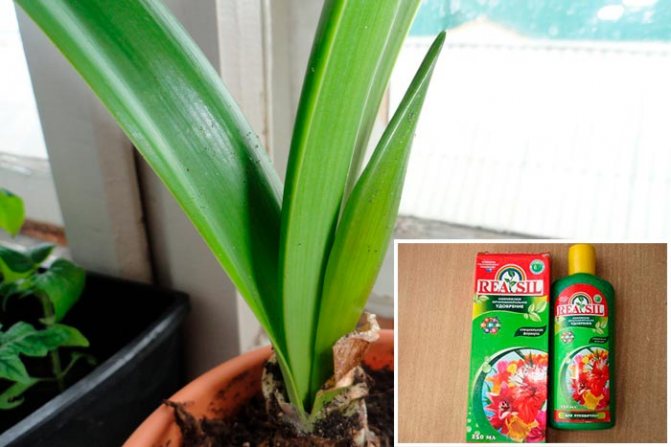

Snowdrops
Scientifically, this flower is also called galanthus. Under the general name, there are more than 50 varieties that differ in shades, shape and size of flowers. This culture received the name snowdrop for its early flowering - when the first thawed patches appear on the ground. The winter-hardy and unpretentious culture feels great both in open areas and in partial shade and shade of trees. The nature of the soil also does not matter much, as long as there is no stagnant water.
Snowdrops are planted in autumn - in August. With a warm autumn, September or October is quite suitable, and even November when planting in flower beds and indoor ground. Reproduction of Galanthus is carried out by daughter bulbs, which appear on parent plants in an amount of 2-3 pieces per year. Planting with seeds is also possible. It should be carried out immediately after collection. Seed plants bloom only 4-5 years after planting.
Dormant period
The rest period is a state in which the main physiological processes slow down or stop altogether. There is no visible growth of shoots, leaves, peduncles. Most bulbous and corms are characterized by a deep dormant period. During this period, indoor flowers lose their foliage.
Plant maintenance in winter:
- Before deep dormancy, stop feeding, gradually reduce the frequency and volume of watering.
- Move the plant to a cool room with a temperature of 8-12 ° C. Store tubers and bulbs in a dark, dry place. If the temperature is high, the bulbs can dry out, especially if they are small.
- As soon as with an increase in daylight hours, the tubers have sprouted, start caring for them - plant them in a pot, put them in a bright place, the spring sun rays will not harm the plant.
- Increase the amount of water for irrigation gradually.
In some plants, during the dormant period, growth is suspended, and the leaves are preserved. The optimum temperature for the content is 10-14 ° C, minimal watering is required.
Summer-flowering varieties
Such plants will look good in flower beds, as well as in mixborders among shorter garden flowers. We recommend placing them in the center of the composition, where the exquisite shape of the flowers will hardly leave anyone indifferent.
After flowering, dried foliage can be successfully masked with other plants.
We advise you to choose the following decorations for your summer garden:
- begonias;
- gladioli;
- anemones;
- calla lilies;
- liatrices;
- ixia;
- freesia.


Anemones at their summer cottage
Vallota
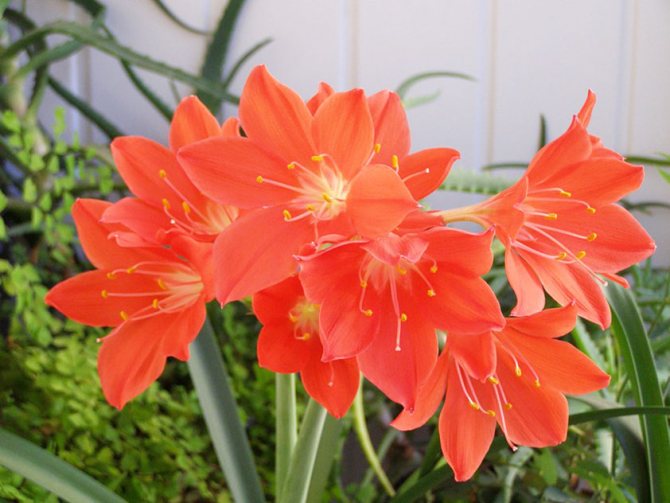

The plant also belongs to the amaryllis family, native to southern Africa. Vallota has narrow elongated leaves characteristic of the species - more than half a meter long and only one centimeter wide. A distinctive feature of the vallotta is the dark red base of the leaves (see photo).
Flowers have petals more often of a red hue, but sometimes pink, white specimens are also found. The peduncle is low, on one there are several lush buds at once. The bulb gives multiple babies, so there are no problems with the reproduction of the plant. The leaves of the plant do not fall off, allowing the wallot to remain attractive all year round.
Ledeburia
This bulbous plant is represented by 16 species. The most popular among flower growers are Ledeburia Cooper, on the brushes of which up to fifty bell-shaped flowers bloom, and Ledeburia public, whose brushes bear up to 25 green-purple bells. Both of them are very similar to each other, so it is sometimes difficult to determine from a photograph which type of lidiburia is captured on it.
By the way, the leaves of ledeburia are also of decorative value, which the main thing is not to forget to wipe so that dust does not accumulate on them.
Hippeastrum
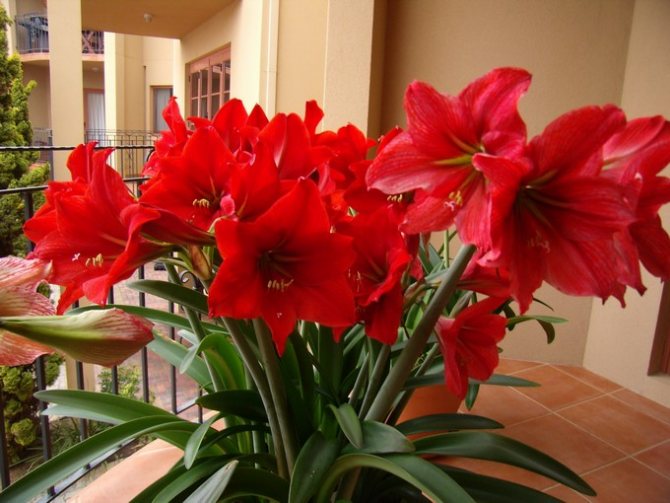

The plant has a rounded large bulb, reaching a diameter of 11 cm. As you know, the flower itself grows impressive in size, its bud is also quite large. From one to six flowers appear on one powerful peduncle.
Flowers have a funnel shape, characteristic of many bulbous, with a rather narrow tube base (see photo). The petals are slightly bent outward along the edges, which gives the plant a great decorative effect. Hippeastrum blooms in winter or spring, very rarely in summer, never in autumn.
The plant is bordered by spectacular long leaves: bright, green, belt-shaped in shape. In combination with bright large flowers, they look very harmonious.
The plant, like most of its relatives, is propagated by daughter bulbs formed by the mother. However, seed reproduction is also possible. In care, the plant is unpretentious, rarely affected by pests, and is a little sick. However, it is undesirable to overflow the hippeastrum with especially cold water - in such conditions, the roots of the plant can rot.
Gemantus
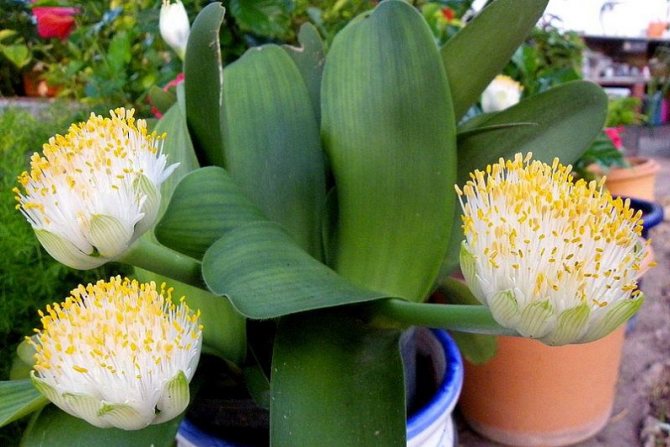

An evergreen ornamental plant belonging to the amaryllis family. The plant is found in the wild exclusively in South Africa; nowhere else in the world does it grow "wildly" (see photo).
The people are called "elephant's tongue" for the rough and very wide leaves. In indoor floriculture, two hybrid varieties are usually used:
The second species blooms in a very peculiar way: together the petals it has a cluster of snow-white stamens with yellow tips.
Gemantus Catarina has red flowers. In translation, the name of the plant means "bloody flower", which is quite consistent with its bright red saturated shade of petals. But the white-flowered version is more popular in indoor floriculture. The flowering period of the hemantus is late summer-early autumn.
In care, both types are not capricious, the watering needed is moderate, and during the rest period it is completely rare. The foliage remains green and decorative all year round. This plant is never tall, usually the height of the hemantus does not exceed 40 cm.
It is impossible to keep the hemantus in direct sunlight - its leaves can burn and dry out at the tips. Therefore, on the southern windowsill, shade the window with paper or a light cloth. As a top dressing, complex compositions for bulbous plants are suitable, during the growing season they feed the hemantus two or three times. In winter, a rest period is needed with a content at a temperature of + 15-18 degrees.
Soil for small-bulbous
Of course, fertile, light, devoid of stagnation of melt, rain and irrigation water, with a neutral reaction of the environment. Considering this, if you use manure, then only well rotted (2-3 kg per square meter for digging). And if the soils of your site are such that you can safely open a quarry and extract clay, then by all means add a bucket of river sand per square meter, mixing well with the soil. By the way - with heavy rains and watering, sand can slowly "run" into the lower layers of the soil, again making it oak. Therefore, periodically add a mixture of your tough soil and river sand, mixed in equal proportions.
When planting small-bulbous plants in the near-trunk strip of any tree, which is quite acceptable, in the autumn period use humus to mulch these plants, manure in this case is completely inappropriate.
Gloriosa
This bulbous plant belongs to lianas, its climbing stem washes to decorate the interior of the living room or hallway. Gloriosa flowers are especially beautiful. In the photograph, it is difficult to convey how strongly their petals resemble a flame dancing in the wind.
If you want to breed this houseplant, it must be borne in mind that the gloriosa tubers are poisonous, so you cannot even transplant it without taking serious precautions. So, despite the beautiful name, gloriosa is very insidious.


Clivia
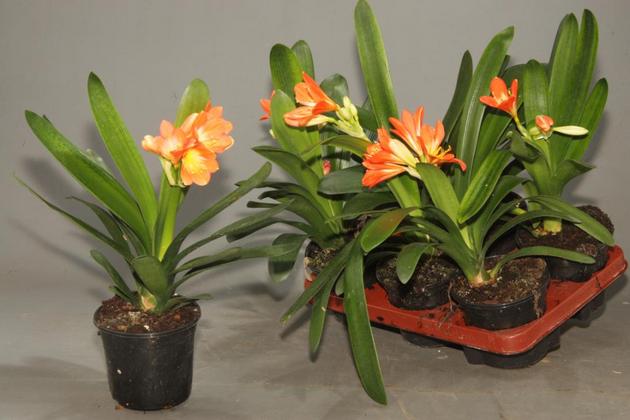

The plant is native to southern Africa, where, in fact, almost all known decorative bulbs originated. Clivia is a perennial that grows up to 60 cm in height. If the care is good, clivia can live for several decades, annually pleasing with its flowering (see photo).
The leaves of the plant are beautiful, glossy, have a leathery texture, and form a false tube in shape. The flowers are luxurious, have an orange-red color, the tips of the petals are pointed, forming an umbrella shape.
It is best to grow clivias on a well-lit windowsill with a constant outside temperature and careful maintenance. The plant propagates usually by seeds, since babies on the mother's bulbs rarely appear at home.
Why don't they bloom
Florists often face such a problem, common to all bulbous plants - houseplants refuse to bloom. Usually this problem is associated with lack of care and most often - with the lack of a quality rest period.
In addition, the following reasons for the lack of flowering are possible:
- content at too low a temperature (do not forget that all bulbous are thermophilic);
- lack of light;
- lack of dressing;
- damage by pests, diseases.
To cope with the problem, it is necessary to mobilize and strengthen the care of the plant. It is important to create comfortable conditions for the bulbous flower: warmth, sufficient lighting, nutritious, loose soil, it should be watered sparingly and only with warm water.
Also organize regular feeding with complex formulations. And to stimulate the plant to bloom and activate its vitality, spray the flower with the following preparations:
So, we got acquainted with the most popular and decorative representatives of bulbous plants used in indoor floriculture. The choice is rich - in the article we have listed only some of the worthy representatives of the bulbous, in fact, much more of them are suitable for home breeding. Graceful bulbs will become a real decoration of the interior, make any apartment more comfortable and delight you with magnificent flowering.
Hello, I am Anastasia and I have devoted half of my life to indoor plants. My apartment is more like a greenhouse. I'm not a super pro, but I know a lot about my favorites. And today I will share about the best bulbous plants for home gardening.


Valuable - in the safe
Well, almost like that.If you have acquired valuable small-bulbous ones, then it is safer to plant them in plastic containers or clay pots.
there are also special plastic baskets for planting. In them, the plants will be protected from rodents, they are not so afraid of snails and slugs, various underground pests, and it will be much easier to dig up the bulbs. It's time for digging and dividing - they removed the container from the soil, put it in partial shade, gave the bulbs a couple of days to ripen and divided it, and in this case, a neat deepening will remain in the flower garden, and not a site that has been dug, like from laying a water supply system. In addition, the onion itself and the children in such a container are like in a house - not one will be lost, and if you still show ingenuity and write the variety or type on the container wall with an indelible marker, it will be generally great. Another plus of planting in containers is that the bulbs can be planted as tightly as possible to each other, thereby minimizing the space and enhancing the overall flowering. There is only one drawback - the bulbs for subsequent planting are smaller due to the limited feeding area.
Colchicum
Another name for colchicum is colchicum, it is also very well known to flower growers. This is a flowering bulbous plant, quite suitable for indoor floriculture.
Colchicum reaches a height of only 20 cm, so it does not take up much space. At the same time, it has delicate and rather large flowers that are pleasing to the eye. Seeing colchicum in the photo, many will probably want to contemplate it and on their windowsill it is quite possible, since the plant is very common. It blooms all summer, which is also good news.
Zephyranthes
This bulbous plant is also called "upstart". This name is due to the fact that the flowers of zofirantes bloom almost immediately after the appearance of the peduncle. The flowering period is from early spring to mid-summer. The petals of a pleasant pink border the yellow-orange stamens. It looks very beautiful, which is confirmed by the photos. The flowers are single, about 8 cm in size, that is, quite large. Therefore, zofiranthes is able to decorate an apartment by appearing on the windowsill in any room.
Adaptability
Small-bulbous are usually not capricious, they adapt to our conditions well, tolerate winter and can even settle in the garden, like at home - to grow, grow, reproduce. However, not all species, alas, are so simple. For example, Juno it is better for beginners not to touch it due to the special conditions necessary for them.
You should know that reticulated iridodictium, or simply - bulbous iris - will live only 2-3 years, and then suddenly it will not appear. You should not worry about this, such is its nature.
Hyacintoides, and even the same iridodictiums, may well freeze out in winter, especially if frosts hit the soil that is not yet covered with snow.
Erantis and erythronium (kandyk) cannot do without moisture at all, and even with a slight drying out of the soil, they usually die. Here, by the way, you can make an important addition regarding the purchase of small-sized plants - always make sure that the bulbs are alive, resilient.
Place to place
When choosing a place, rely on the origin of the species, we send all forest types of snowdrops, forest trees, corydalis, kandyks to the shade and "shove", for example, under the crowns of trees. We take out the rest in the sun and place it under its rays.
Important: small-bulbous ones were not so simply named, their bulb is small, therefore the maximum embedding depth is no more than 10 cm, otherwise you will bury your miracle forever. Well, in general, the calculation of the depth is simple - the smaller the bulb, the finer it is in the soil and must be placed - no deeper than 3 bulb heights. Ideally, so that the bulb does not rot in the soil, a teaspoon of river sand is poured into the bottom of the hole.
Tuberous garden flowers
They are characterized by the presence of growths with axillary buds on the roots. Among the popular ones are the following:
- Crocosmia (montbrecia)
... The length of the stems reaches 100 cm. Flowering time is the second part of summer. Tuberous flowers are represented by tubular or star-shaped flowers. Among the most popular are: Golden, Massonorum, Pottsa, Lucifer and others. - Erantis (springer)
... The buds bloom in March. Garden flowers are yellow. The height of the stems reaches 30 cm. The following species are known: Wintering, Long-legged, Cilician, Star and others. - Begonia
... There are garden plants with different growth periods. Height from 10 to 300 cm. Flower petals open during the summer. The most popular are the following varieties: tuberous, multi-flowered and drooping.
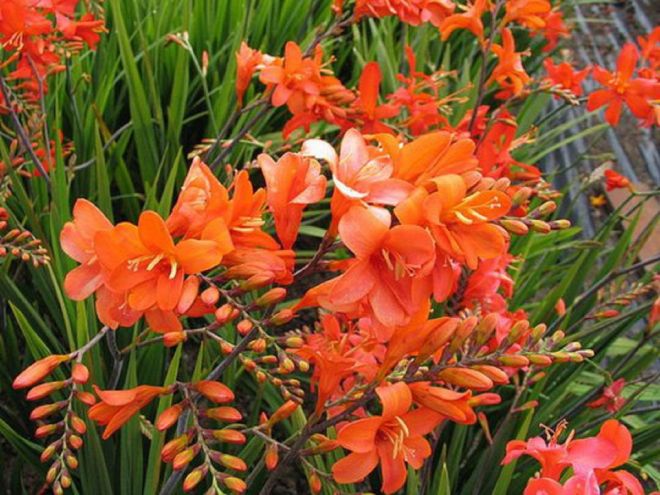

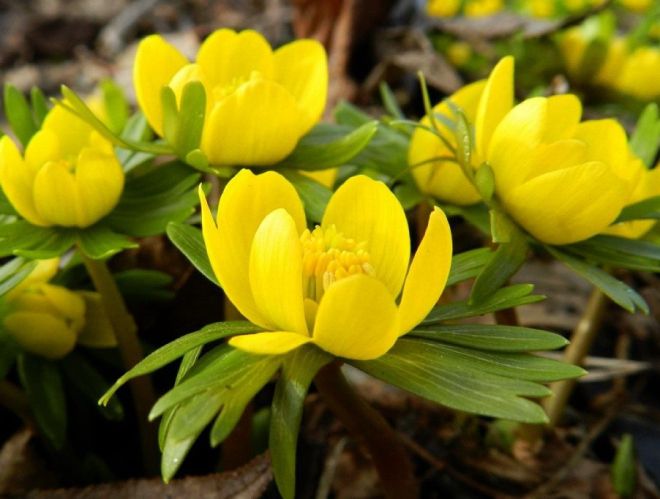



Amaralis
This houseplant blooms in autumn, has an incomplete peduncle reaching a length of 50-70 cm. At its top, from 8 to 12 large bell-funnel-shaped flowers bloom. Beautiful, as you can see in the photo, bright pink flowers smell sweet, filling the room with a pleasant aroma. However, this is not always good for the bedroom, so it is best to stir amaralis in the living room or hallway. Moreover, this indoor flower belongs to poisonous bulbous plants. If your family has small children, kittens or puppies, then add his name to the "black list".
Amaralis leaves appear at about the same time as the peduncle. They are smooth, grooved, belt-shaped, reaching a length of half a meter.
Amaralis bulb resembles a pear covered with small scales. This houseplant produces daughter bulbs annually. A significant part of the year is dormant.


